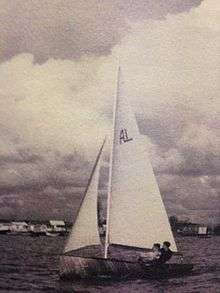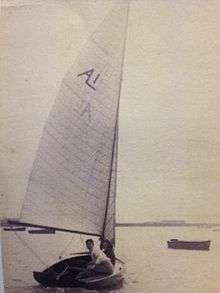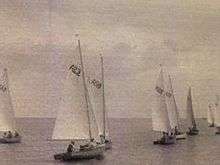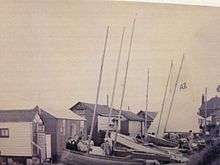Albacore (dinghy)
The Albacore is a 4.57 m (15 ft) two-person planing dinghy, for competitive racing and lake and near-inshore day sailing. Hulls are made of either wood or fibreglass. The basic shape was developed in 1954 from an Uffa Fox design. Recent boats retain the same classic dimensions, and use modern materials and modern control systems, making it ideal for the recently graduated college racer, as well as those with less experience.
| Development | |
|---|---|
| Year | 1954 |
| Boat | |
| Crew | 2 |
| Draft | 1,270 mm (4 ft 2 in) (foils down) 200 mm (8 in) (foils up) |
| Hull | |
| Hull weight | 109 kg (240 lb) |
| LOA | 4,570 mm (15 ft 0 in) |
| Beam | 1,550 mm (5 ft 1 in) |
| Sails | |
| Mainsail area | 8.36 m2 (90 sq ft) |
| Jib/genoa area | 3.25 m2 (35 sq ft) |
| Upwind sail area | 11.61 m2 (125 sq ft) |
| Racing | |
| D-PN | 90.3 |
| RYA PN | 1062 |
.jpg)
A deep airfoil section centerboard and rudder make the Albacore highly manoeuvrable.[1] The Albacore's rig uses swept spreaders supporting a tapered mast, a powerful vang, and adjustable jib halyard and other sail controls to depower in high winds. This adjustability enables light crews and heavy crews to race head-to-head in all but the most extreme conditions. It does not have a trapeze or spinnaker, and hence avoids the difficult handling of sport boats. The powerful rig and easily driven hull give excellent performance over a wide range of wind and wave conditions.
The 2011 International Champion described the Albacore as a boat that is simple to get into at first, but one that will challenge the tuning and tactical skills of a sailor for the rest of their life.[1] Recent champions have been "graduates" of college sailing teams.
The First Albacore
The first Albacore (number 1) was built by Clive Dollery and Dave Lowe, who adapted Uffa Fox's design. They were both junior members of the Locks Sailing club in Portsmouth, England (UK) in the 1950s. They crewed in a variety of boats including Lowe's National 12, but they were also keen amateur boat builders.
Dollery wanted a boat to race. They wanted to start with a ready made hull. Lowe's father and Uffa Fox had discussed and agreed to build a non-standard Flying 25 with significant changes made. So they assumed that the same agreement could be applied to a Swordfish sailing dinghy also designed by Fox.
A Swordfish hull was obtained from Fairey Marine via a local boat builder. They modified the hull moving the position of the mast, cutting a slot and fitting a keel box. Several members of the Locks Sailing club were interested in this project and formed a committee with Fairey Marine, resulting in the 'committee modified Swordfish'. This was renamed the 'Albacore'. The committee agreed that this boat be allocated Albacore number 1.
The Locks Sailing club soon had a fleet of about 20 Albacores that raced regularly against one another. in 1958 the National Albacore championships were held under the burgee of the Locks Sailing Club, in Langstone Harbour with a fleet of 46 boats.[2]




Popularity
About 8,200 Albacores have been built.[3] The class is actively raced in Canada, the United Kingdom, and the United States. Albacores are also used for adult and youth sail training,[4][5] and for leisure sailing.
The Albacore was ranked 16th most popular one-design sailboat in North America in 2010 by Sailing Anarchy,[6] and 38th most popular in the UK from 2001 to 2011 by Yachts and Yachting.[7]
There is a particularly large concentration of Albacores in Toronto, Ontario, Canada where the Friday night club series sees an average of 45 boats and peaks of over 60 boats on the start line every Friday during the summer sailing season.[8]
Older Albacores are commonly found in vacation areas such as Ontario Cottage country.
Competitions
The Albacore class offers an active racing program, attracting experienced sailors as well as new enthusiasts. With local club racing, regional regattas, and international championships, the class provides racing opportunities for every level of experience and interest. In addition, Albacores compete with other boats in a mixed fleet by means of the Portsmouth Yardstick handicap scheme. Its Portsmouth number is 1062[9] and its D-PN is 90.3.[10]
The Class has a biannual International (World) Championship with the venue alternating between the three key countries where the class is sailed. The earliest such event was in 1971, and was won by Canadians Jack Langmaid and Nancy Langmaid in a Fairey Marine Albacore.[11] The 2005 International Championship was held in Lyme Regis in Dorset, UK. The 2007 championship was held at the West River Sailing Club in Galesville, USA. The 2009 championship was held in Largs, Scotland, UK and was won by US sailors Barney Harris and David Byron. The 2011 International Championship was held in Toronto, Canada and was again won by Harris and Byron. The 2013 International Championship was held in Abersoch, UK and once again was won by Harris and Byron. The 2015 championships was held in Sarasota, USA and won by Canadians sailors George Carter and Almir Tavares.[12] The 2017 Albacore Internationals will be hosted by the Weymouth and Portland National Sailing Academy in the UK August 5–11, 2017.[13]
Manufacture
Two manufacturers of Albacores produced boats in 2011 to 2013: Ovington Boats in the UK and Hapco Marine in the USA. The boats were primarily delivered to UK, Canadian and US destinations.
Notable earlier manufacturers include Ontario Yachts, Skene, Woof, Kingsfield Marine, Fairey Marine, Grampian Marine, McGruer&Clarke, JD Young, Rondar, Lockley, Lockley-Newport, and Whitby Boat Works.[3]
Family use
The hull weight of an Albacore is 109 kg (240 lbs). Therefore, the Albacore can be road-trailered, with 1 or 2 Albacores behind a typical family car. With appropriate road-trailer design, the boat can be loaded and unloaded using only 2 people.
The Albacore is frequently used as a first boat for those who are just learning to sail, and as a very competitive racer for more advanced sailors.
Regatta results show that this class of boat is often sailed by husband/wife and parent/child combinations,[14] and that some of the all-women teams are the most competitive in the class.
Rigging and Materials
All Albacores ever made are considered identical for the purpose of racing, and can race together without a handicap. However, many details and materials be improved or modified at the choice of the individual owner or manufacturer, provided that the basic dimensions and materials meet the class specification.[15]
The rigging of early Albacores was very simple, including such basic features as a flat centerboard and fixed jib fairleads. This rigging allowed only limited adjustability of sails.
Modern Albacore designs have evolved sophisticated control systems for their running rigging and standing rigging. This greatly increases their versatility compared to earlier boats, and they can be sailed in 2 knots to 25 knots of wind.
A typical modern design for an Albacore includes:[16][17]
- Epoxy foam sandwich fibreglass hull (Modern wood hulls are also manufactured, but are less common)
- Tapered aluminum mast
- Lightweight aluminum boom
- Automatic fly-away jib stick
- Moulded or wood/fiberglass composite centerboard with symmetric airfoil cross-section
- Kick-up rudder with symmetric airfoil cross-section
- Suction self-bailers (which empty a boat after capsize in 4 minutes)
- Adjustable continuous 16:1 vang and 12:1 jib halyard, rigged to side control panel
- 4:1 main-sail outhaul, 2:1 main-sail Cunningham, jib Cunningham
- Adjustable hiking straps for crew and helm
- Extended jib tracks for high- & low-aspect jibs
- Split-tail mainsheet
- Deck mounted 6:1 mast pre-bend adjuster and 2:1 rope mast ram
External links
References
- http://usaa.albacore.org/node/9
- National Albacore Association, Newsletter No. 121, Spring 2014
- http://registry.albacore.org/latest
- "Archived copy". Archived from the original on 2013-09-08. Retrieved 2013-01-27.CS1 maint: archived copy as title (link)
- http://www.kanatasailingclub.com/index.php?pr=Training
- http://webuser.bus.umich.edu/townsend/Albacore/OneDesignSurvey2010.htm
- "Archived copy". Archived from the original on 2014-03-06. Retrieved 2013-01-26.CS1 maint: archived copy as title (link)
- "Archived copy". Archived from the original on 2011-06-29. Retrieved 2011-01-14.CS1 maint: archived copy as title (link)
- "Portsmouth Number List 2012". Royal Yachting Association. Retrieved 31 July 2012.
- "Centerboard Classes". US Sailing. Archived from the original on 16 August 2012. Retrieved 31 July 2012.
- "Archived copy". Archived from the original on 2014-07-27. Retrieved 2013-04-22.CS1 maint: archived copy as title (link)
- http://regattanetworks.com/event/9155#_newsroom+results
- http://www.albacore.org.uk/alb/index.php/fixtures/peak-ryzex-albacore-internationals
- "Archived copy". Archived from the original on 2012-11-11. Retrieved 2013-01-27.CS1 maint: archived copy as title (link)
- http://www.albacore.org.uk/alb/index.php?option=com_content&view=article&id=24&Itemid=36
- "Archived copy". Archived from the original on 2013-02-19. Retrieved 2013-01-26.CS1 maint: archived copy as title (link)
- http://www.hapcomarine.com/page1/page1.html